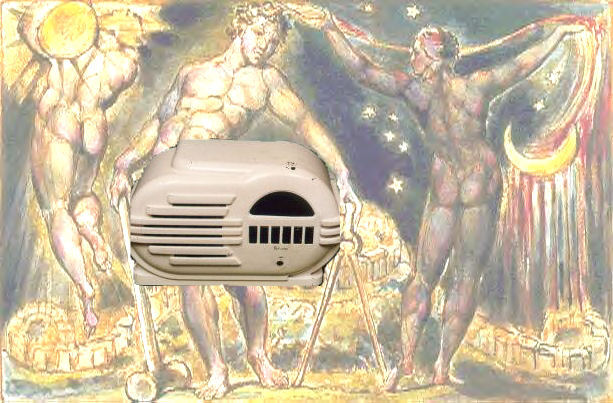|

Realism
This is what is called 'invisible' post-production editing. The
production does not call attention to itself. You go for continuity
editing.
Non-realism
You are not offering a 'mirror' on the Lifeworld. You may wish
to have the play draw attention to itself.
You may wish the play to comment on the production.
You may wish to go for - to use film terms - shock cutting
(cross-cutting alternating two or more lines of action going
on in different places), montage etc.
You may want a rhythm that is jerky, disjointed.

Music
bridge and music FX
You have to account for copyright of
music.
There are two types of music here:
Music in the story space - in the same acoustic as the scene.
The theoretical term is 'diegetic' music.
Music outside the story space - not in the same acoustic as the
scene - in best quality audio. This is the convention so the
listeners know that the music does not 'belong' to the story
space of the characters' dialogue. The music makes a comment
on the story and the characters. The theoretical term is 'non-diegetic'
music.
You can also treat the quality of the music and make a transition
from the music in the story space (diegetic) into outside the
story space (non-diegetic).
Examples:
Music in the story space
Scene location - teenager's bedroom in 1965
Music - Beatles' hit
Music introduced at the beginning of the scene in the acoustic
of the teenager's bedroom. It is faded down and under the dialogue,
but remains under. At the end of the scene, the music - still
in the bedroom acoustic - is faded up under the last words of
the scene and then further up, and then faded out, or straight
cut. This is a convention in radio drama.
Music from inside the story space (diegetic) and then into
outside (non-diegetic)
Same situation as above
Scene location - teenager's bedroom in 1965
Music - Beatles' hit
As before, the music is in the story space, under the dialogue.
At the end of the scene, the music in the acoustic of the bedroom
is faded up (as in the above example), but once the dialogue
is finished, the music is treated, so that is changes its quality,
and makes a transition into best quality audio.
This is also a convention in radio drama and tells the listeners
that we are now in the scene boundary. The music will now comment
(ironically? joyfully? mournfully?) on the scene and prepare
us for the coming scene.

Music bridge
Music, in best quality audio, is faded in under the dialogue
at the end of the scene, brought up for the scene boundary, and
then faded under the dialogue at the beginning of the new scene.
In the overall meaning of the play, the music could be a repeating
motif of the same music choice, or from a music genre - such
as standards of the 1960s (play about teenagers in that decade).
SFX (sound effect) bridge and Atmos bridge
This can be used in realist plays and the nonrealist.
Use in a realist play:
This indicates a lapse of time between two scenes. For example,
in Rhys Adrian's play, 'The Clerks', the two tramps of the title
keep up a dialogue spread across an evening and into the next
day. The scene divisions are more to do with their conversation
topics. Scene boundaries are indicated by the FX atmos faded
up, and across the boundary, and then faded under but continued
under the new scene dialogue. This convention lets us know that
the location is ongoing, as the presence of the characters involved,
but that there are transitions in the time scenario.
A SFX is also used as a bridge - in one case, a passing police
car, and an ambulance in another. These SFXs are in the same
acoustic and location as the scenes, but are faded up and then
down to mark the scene boundary. They are faded up to a higher
level than as an FX during the middle of a scene. We have the
impression of the 'camera' focusing on the passing emergency
vehicles and watching them speed away. We focus away from the
characters and from this convention, we know that we are moving
into a new scene.

You use them in different combinations. All relates to the overall
rhythm and meaning of the play, and where you are with this sequence
of scenes. And what mode (realism or not) and style are you working
in?
If there is an exciting climax to a scene, a revelation or some
action, you may decide to go to silence before the next scene,
to allow your audience time to absorb the information and emotion,
and to catch up.
END OF SCENE - (Revelation - 'He's your father!') Fade to silence
OR Straight cut on the revelation
BETWEEN SCENES - 2 seconds silence
BEGINNING OF FOLLOWING SCENE - Fade in or straight cut in
Note: 'Archers' fade if you fade out to silence (2 seconds) and
fade in the new scene
Or it may be better to keep up the pace. You are near the end
of the play, and you are building to the most important final
scene. You want to increase the excitement.
END OF SCENE - Straight cut
Nothing before the next scene
BEGINNING OF FOLLOWING SCENE - Straight cut into the new scene
This is very effective the play is a police thriller. Let's say
you are involved in a car chase near the end, and leading to
the capture of the crook. Straight cut from the police and our
heroine in their car, to the evil villain who has captured a
child in the leading and speeding car.
Here is another example - the 'talking heads' play. This relies
on dialogue for the most part. Your aesthetic as a director could
well be standard production. And as has been said about standard
production, the choice of an aesthetic suits the script. Many
'talking heads' plays have an acute ear for dialogue and atmosphere.
Speech rhythms and psychologically acute acting, along with superb
timing will realise in a ringingly alive and observant play.
A standard production
play can show the deepest sensitivity, experience and technical
expertise. Many standard production radio plays are ear-opening,
exuberant, sharp, splendidly alive and - if afternoon plays -
popular entertainment of high order. Some are superlatively good. |




